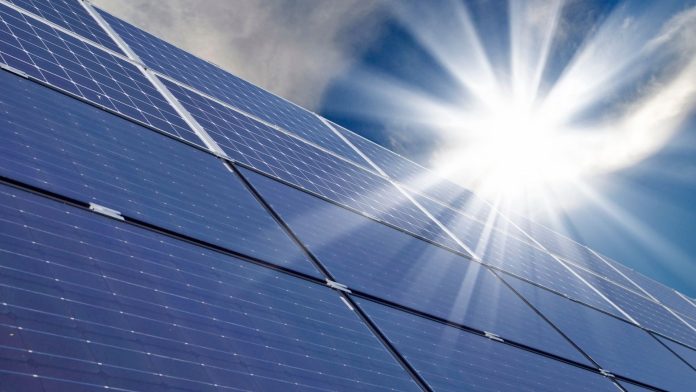Solar energy is breaking records worldwide and in Europe, said Walburga Hemetsberger, CEO of SolarPower Europe, the leading European organization in solar energy, at the Sunny Days 2023 conference held last week of May in Bol, Brac. In her presentation, she stated that the path to 2050 is paved with solar energy, citing global and European research that clearly demonstrates how solar energy can provide the fastest path to energy self-sufficiency. This is a goal that Europe wants to achieve before 2050, and it is actively pursuing it due to the energy crisis and the war in Ukraine. “Last year, we reached 1 TW of global solar installations. This growth is incredible, especially considering that just 20 years ago, we had only 2 GW of installed solar capacity, which has grown to 1000 GW in just 20 years, an unprecedented success,” emphasized Walburga Hemetsberger, the director of SolarPower Europe.
From 2 GW to 1000 GW in just twenty years
How did this growth happen? The answer is simple, according to Walburga. The construction costs of solar power plants and wind farms have proven to be much cheaper and cost-effective compared to fossil fuel, natural gas, and nuclear power plants during the observed period. Solar capacity will double every three years.
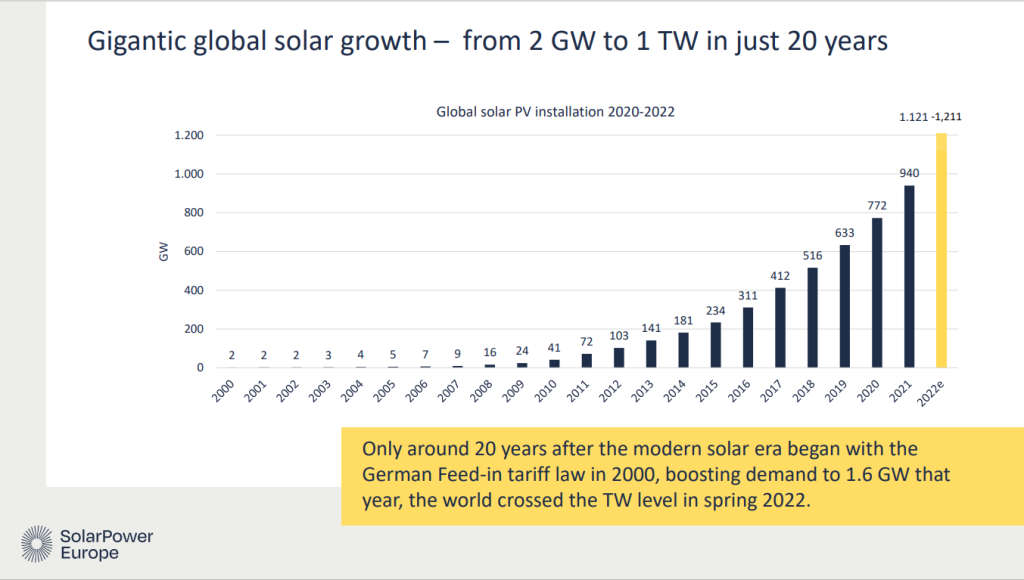
Solar capacities will double every three years
Last year, 40 GW of solar power was installed in Europe. “For those who don’t understand this number, let me compare it to nuclear energy. A nuclear power plant has an approximate capacity of 1 GW, which means that in Europe, we installed solar power plants with a capacity equivalent to 40 nuclear power plants last year. This represents an increase of 47% since we installed only 28 GW of solar power in 2021.”
Germany, Spain, and Poland developed the most solar power last year
Sunny Croatia, which has much higher insolation than Germany and Poland, ranks at the bottom of the list of installed solar capacity in Europe. “I like to emphasize the example of Poland, which most people perceive as a cold country with little sunshine, but it ranks third in terms of annual solar installations. It is followed by the Netherlands and France, although the situation is changing rapidly. This is the statistics from the end of 2022, but in the first quarter of this year, Italy overtook France and is now in fifth place,” said Walburga.
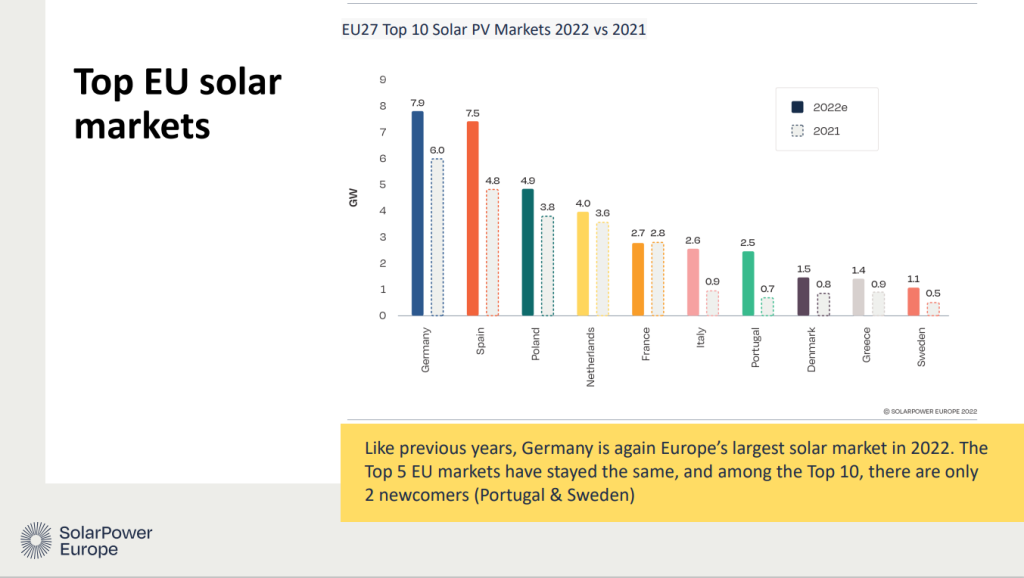
This year, the EU is expecting up to 60 GW of new solar power
Looking at the total installed capacity for 2022, Europe had 200 GW, and all indicators point to further strong growth. According to SolarPower Europe’s moderate scenario, they expect around 54 GW of solar installations this year, but they could reach 60 GW, according to Walburga Hemetsberger.
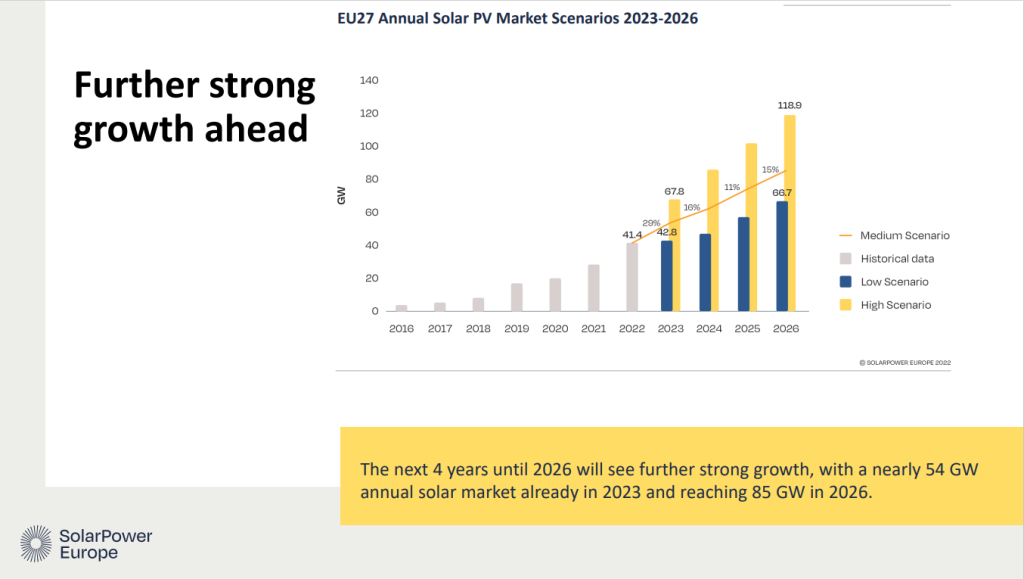
She mentioned that a few months ago, the International Energy Agency (IEA) in collaboration with the European Commission (EC) issued a report analyzing the measures needed to cover the gas supply shortage that Europe may face this winter. It concluded that Europe will be able to meet its energy needs if it installs 60 GW of solar power this year. According to SolarPower Europe’s moderate scenario, they expect the EU to install 85 GW by 2026, but installations could reach up to 100 GW.
“That brings us to a total installed capacity of 500 GW in just four years. Today, we have 200 GW, and those 500 GW are half of what we want to develop by 2030. We truly believe that we can have 1 TW of installed solar power in Europe by 2030,” stated Hemetsberger.
Countries that have entered the Gigawatt club
The strong development of solar energy has spread across the entire continent, with last year seeing 10 European Union countries installing over 1 GW of solar power plants. SolarPower Europe believes that by 2026, eighteen countries will surpass the 1 GW threshold for installed solar capacity, and among them, they see Croatia on that list. Slovenia could have over 2 GW by 2026, which is not an unrealistic goal, and based on all indicators, Slovenia is expected to reach over 1 GW of installed solar capacity this year. According to SolarPower Europe data, Croatia achieved significant growth last year, and the continuation of that growth is expected this year as well.
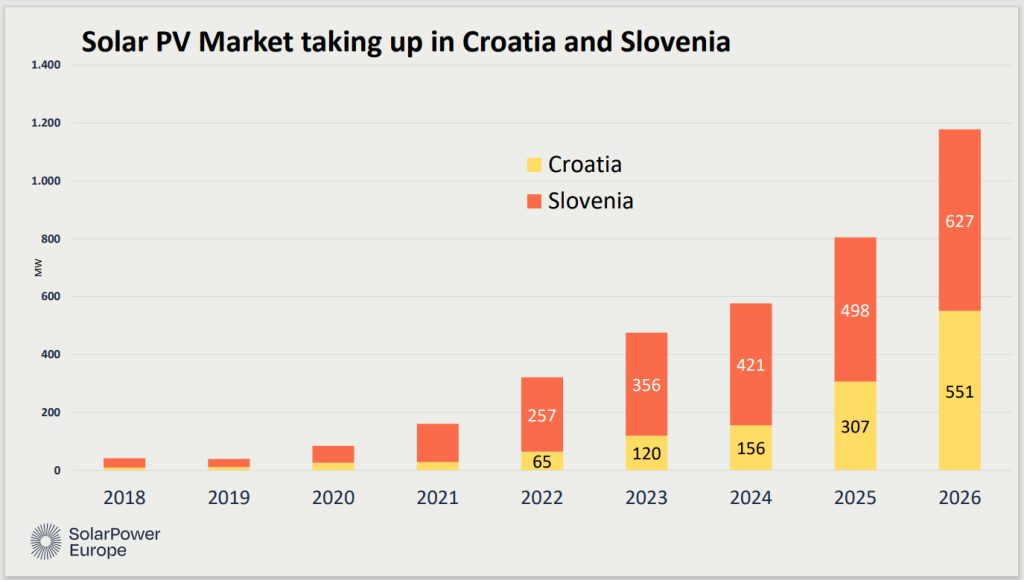
There has been a visible increase in annual solar installations in the past two years. This year, SolarPower Europe expects Croatia to have a growth of 120 MW and Slovenia to have a growth of 356 MW.
It is also predicted that Croatia will have 1340 MW of solar power by 2026, which is over 1 GW.
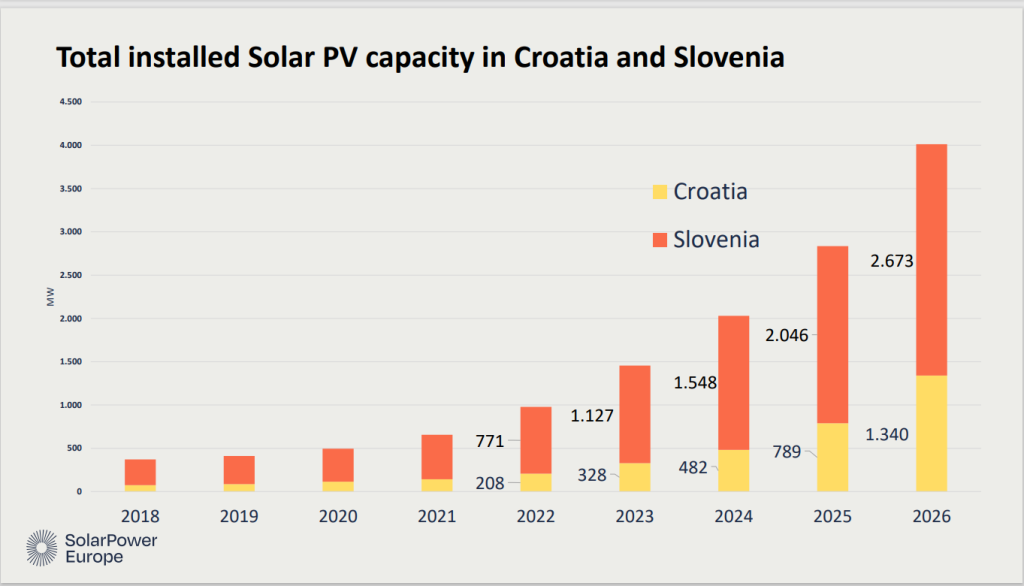
The European Commission promotes the development of solar energy
The European Commission strongly advocates for the development of renewable energy, and they promote solar energy development through advertising, which was unthinkable a few years ago, according to Walburga. Solar energy used to be just a renewable energy source that required investment, but now, due to its strong growth potential, it has gained the status of a central technology for the energy transition. Even the REPowerEU plan includes a solar strategy, which is the first strategy solely focused on solar energy. The European Commission has also increased its growth projections for solar energy, which were previously quite low. The plan now is to develop 750 GW of solar power by 2030, or 400 GW by 2025.
“We at SolarPower Europe believe that Europe can develop 1 TW of solar power by 2030. According to a moderate scenario, it can be 920 GW. The European Commission has not yet set a goal of 1 TW, but we believe that even the goal of 750 GW is a strong message for the development of solar energy compared to the previous goal of 400-500 GW.”
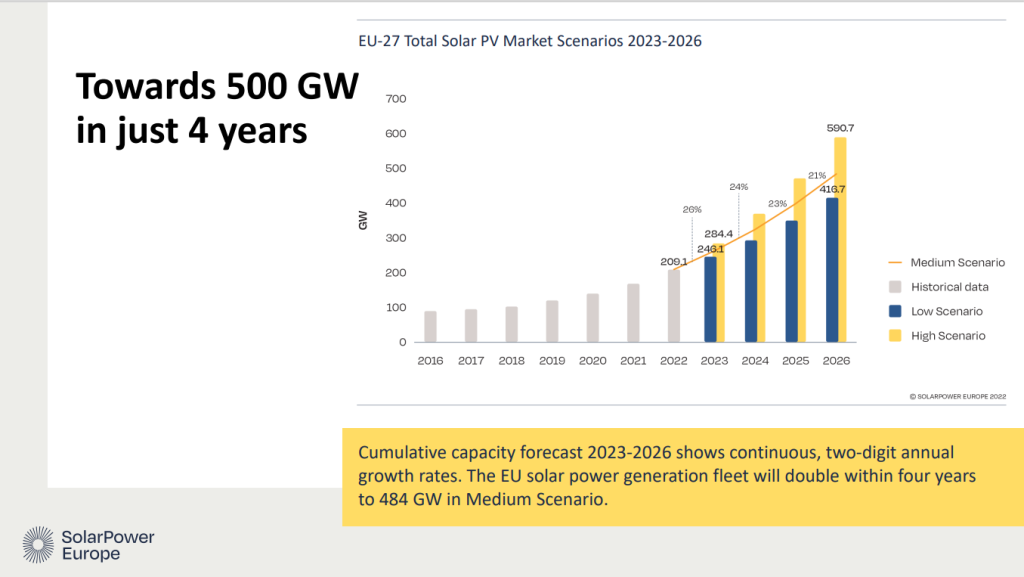
By the end of June this year, the Member States of the European Union must submit their revised National Energy and Climate Plans to the European Commission because the previously adopted plans do not reflect the current reality and can be more ambitious, Walburga believes. According to analysts from SolarPower Europe, Croatia has the potential and opportunity to install up to 7 GW of solar power by 2030.
Challenges on the path to 1 TW of solar power in the EU
The development of 1 TW of solar installations is an achievable dream, but not without obstacles. The solar sector, as mentioned in Walburga’s presentation, currently employs around 500,000 workers, and to achieve the desired terawatt scale, Europe will need around 1.5 million workers by 2030. She believes that this is an excellent opportunity for those whose jobs will undoubtedly disappear by then. Permitting procedures for solar power plants across Europe are too lengthy, although there are countries where the situation is better than in others, but the process is still too long.
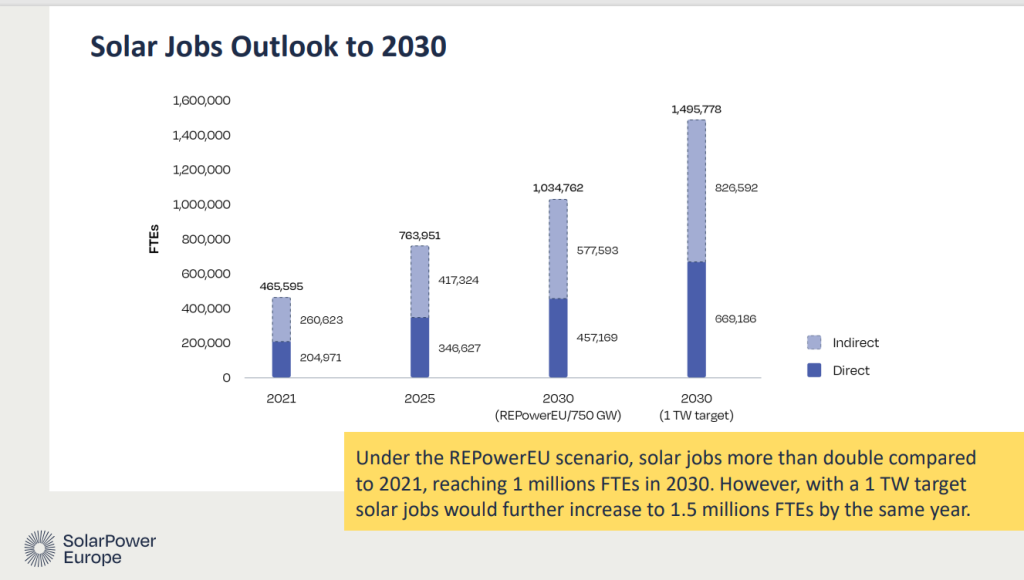
For Europe to achieve its solar goals, a reliable domestic supply chain is needed. Investments in the transmission system and strengthening network capacity are necessary to accommodate new solar installations. “Investing in the power grid is the number one topic at the European level. The European Commission will have to focus on their development, as well as all Member States. Unfortunately, not enough attention is currently being paid to networks and their management. We need to consider how to connect new megawatts to the grid and how to keep that grid stable. I would say there is a lot of work ahead of us.”
Domestic production of solar components
Europe needs a secure and reliable supply chain, not only for solar panels but also for all components in the supply chain. “This is a great opportunity for Europe to redevelop domestic industrial production. We have major companies in Europe, such as polysilicon manufacturers in Germany, but we lack the production of many other components, and we don’t even have a large industrial facility for module production.”
Walburga emphasizes that Europe must not become dependent on importing components from other markets, which is why the European Commission proposes the development of domestic production of 30 GW of all solar elements in the supply chain by 2025, at the latest by 2030.
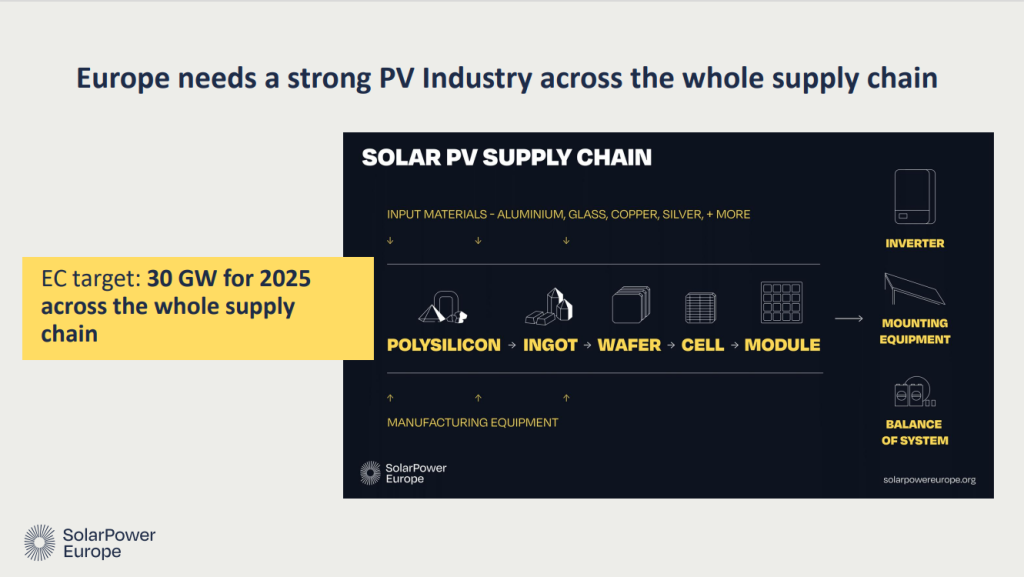
She stressed that Europe must be able to produce the necessary amount of equipment and mentioned that there are factories in China that can produce that amount in just one day. To ensure domestic competitiveness, the European Commission has adopted the Industrial Green Deal, which will boost investments in solar production.
Production in Croatia
It is a great opportunity to open manufacturing facilities in Croatia, stated Walburga Hemetsberger at the end of the presentation. The only solar panel factory in Croatia is Solvis, a member of RESC. It produces 2,800 modules per day and approximately one million modules per year. So far, the factory has produced around 300 MW of solar installations, but Croatia imports most of the other components. It is an excellent opportunity for the development of domestic industry.


